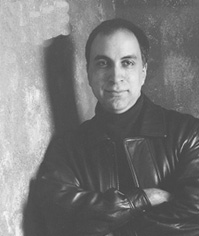
Composer Anthony Cornicello (born in Brooklyn, New York, 1964) writes music that blurs distinctions between performers and electronics, timbre and harmony, composition and improvisation, and explores the boundaries of what may be considered post-classical concert music. His music is vibrant and visceral, full of rhythmic energy and harmonic sophistication, and his forays into live electronics have led to exciting combinations of instruments and processed sound. Cornicello’s background as a jazz pianist is evident not only in the rhythmic activity of his music, but also in his constant investigation of the rich sonorities available from a variety of instruments.
He has been commissioned to write music for the Scorchio Electric String Quartet, ModernWorks! (funding from Meet the Composer/ Commissioning Music USA), the Auros Group for New Music, the Prism Saxophone Quartet, the New York New Music Ensemble, David Holzman, the Group for Contemporary Music, and the InterEnsemble of Padova, Italy. His work has also been featured on the Guggenheim Museum’s “Works and Process” series. Cornicello’s works have also been performed by the Chicago Civic Symphony, Parnassus, ALEA III, Composers Concordance, Madeleine Shapiro, Robert Black, among many other outstanding groups and solo performers. His music has been presented as part of the Darmstadt International Festival of New Music as well as the June in Buffalo Festival.
Cornicello’s Second String Quartet has been recorded by the Atlantic String Quartet; the Second Sonata for Piano by David Holzman (Centaur). More recently, his Post-Modern Waltz was recorded by Eric Moe for Albany Records. A portrait CD of Cornicello’s works is scheduled for 2006 release on Albany Records.
As a performer, he has conducted or played piano in his own works on numerous occasions. While a graduate student at Rutgers, he formed and directed the Janus Ensemble, a group dedicated to contemporary music. More recently, Cornicello has begun performing on the laptop, using a variety of interfaces and the Max/MSP program. Those performances, mostly with EEE!, have had a notable impact on his music, as EEE!’s music ranges from hip-hop to experimental noise. EEE! is based at Eastern Connecticut State University, where Cornicello is an Associate Professor and Director of the Electronic Music Lab.
Cornicello received the Ph.D. from Brandeis University, where he studied with David Rakowski, Eric Chasalow, and Martin Boykan. His teachers also include Charles Wuorinen, Gérard Grisey, and Richard Beirach.
His current fields of interest include developing unusual interfaces for live computer music performances, as well as continuing to investigate resonance and spatialization. His recent and current projects (mostly for string instruments and electronics) have been exploring the latter two, and the series of experimental works ReZenant Garden, performed by EEE! have operated on all three areas of interest. Future projects will include works for instrumental groups or soloists and electronics, as well as turntablists.
Cornicello's works are published by C.F. Peters Corporation and APNM, and he is a member of BMI.
|
|
|
|
|
|

Wednesday, October 12, 2005
EEE!
Yes, it's been a while, but I've been busy.
One of the things that keeps me busy is my performance group, EEE!. It's an all electronic group; well, mostly electronic: sometimes the students use guitars and didjeridos (is that the proper pluralization?). But, the main focus is performance-oriented electronic music - we don't do 'tape' music. That was one of the concerns when we first formed the group - some faculty members were bracing for one of those concerts where you stare and speakers for an hour. We hide our speakers!
Seriously, the group consists of myself and usually around 5-6 students. The music is mostly improvised, although we do perform classic electronic works sometimes. The students play keyboards, guitar controllers, turntables, plus a variety of alternative controllers: the Kaoss Pad, AirFX, and other non-traditional controllers like gloves, touch sensors and other odd things. And, we just got a Theremin, which is a blast. The whole group is processed in Max/MSP, not to mention a bunch of effects units. You can see photos at the EEE! site, as well as hear some sound clips.
This year, we're going up to Quebec City for the ATMI/CMS National Conference, in addition to our usual concert at ECSU. That leaves me planning two concerts, or at least two groups of materials. I'm using some of our more-performed things up in Canada, keeping the new stuff for ECSU. Our 'older' material includes:
Five4 by John Cage. We've arranged this for the group, and we usually play it a few times during the concert - it's only 5 minutes long.
"Totalitarian Democracy" - text by Lawrence Ferlinghetti. A great rant on the current regime in the white house - need I say more? See it here. I'm sure this will go over well in nice, liberal Canada.
ReZenant Garden II - another piece of mine in this cycle of works for electronics. This includes a Didjeridoo and a Gong (played live), some recordings of Tibetan Monks chanting, and a whole lot of processing in Max.
We might do "For 1,2, or 3 Players" by Christian Wolff.
For the home event, we're thinking of doing "Pendulum Music" by Steve Reich, and a few other goodies.
In the future: I'm still planning to do "Mikrophonie I" by Stockhausen. The kids are into it, so it might work. It's a lot, though. I'd also like to do some more Cage - maybe some of those "radio" pieces, and maybe even "Cartridge Music".
As always, I'm open to suggestions of pieces. We have some limitations, especially the lack of formal training amongst most of the students I have here. I've learned how to make the best of it, but it still prevents me from doing traditionally notated works with complex rhythms, etc.
posted by Anthony Cornicello
|
| |



